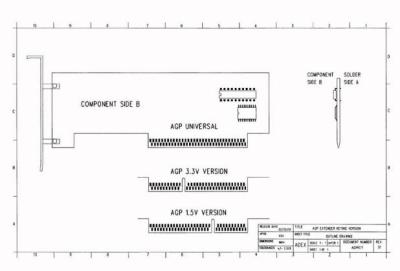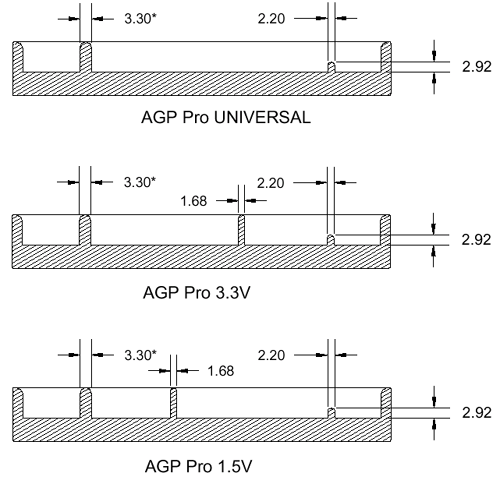Agp Universal Slot
Some AGP slots and cards support only one standard AGP 1.0, AGP 2.0, or AGP 3.0 but most recent cards and slots you're likely to encounter are universal. To summarize: Universal 1.5V AGP 3.0 (U1.5VAGP3.0) slots and cards support 1X, 2X, 4X, or 8X operation at 1.5V or 0.8V, using a universal connector. A U1.5VAGP3.0 card can be. AGP standards have changed since inception way back with Slot-1, BX and PentiumII. Speeds have increased from 2x to 4x and 8x. Voltages have dropped from 3.3V to 1.5V and to 0.8V. The AGP slots In fig 1.1 is a typical AGP Pro Universal slot on a motherboard. We have pointed out the alignment keys, which, in conjunction with the alignment notches on the AGP/AGP Pro video card ensures the card is installed correctly. The two extensions we have pointed out are used to provide extra power to the AGP Pro cards. AGP Pro is a physical specification aimed at satisfying the needs of high-end graphics card manufacturers, who are currently limited by the maximum electrical power that can be drawn by an AGP card (about 25W). AGP Pro caters for cards that draw up to 100W, and will use a slightly longer AGP slot that will also take current AGP cards.
Introduction to the AGP bus
The AGP bus (short for Accelerated Graphics Port) was released in May 1997 for Slot One chipsets, then was later released for Super 7 chips in order to manage graphical data flow, which had grown to large to be handled by a PCI bus. The AGP bus is directly linked to the processor's FSB (Front Side Bus) and uses the same frequency, for increased bandwidth.
The AGP interface was developed specifically to connect with the video card, by opening a direct memory access (DMA) channel to the graphics board, bypassing the input-output controller. Cards which employ this graphics bus theoretically require less on-board memory; because they can directly access graphical data (such as textures) stored in central memory, their cost is hypothetically lower.
Version 1.0 of the AGP bus, which used 3.3 V of power, had a 1X mode that could send 8 bytes every two cycles, and a 2x mode for transferring 8 bytes per cycle.
In 1998, AGP version 2.0 added AGP 4X, which could send 16 bytes per cycle. Version 2.0 of AGP was powered by 1.5 V, and AGP 2.0 'universal' connectors which could support either voltage were released.

AGP version 3.0, released in 2002, doubled the speed of AGP 2.0 with a new AGP 8x mode.

Characteristics of AGP
The AGP 1X port operates at 66 MHz, as opposed to 33 MHz for a PCI bus, giving it a top speed of 264 MB/s (vs. 132 MB/s, shared between all the cards, for PCI). This gives AGP better performance, especially when displaying complicated 3D scenes.

When AGP 4X was released, its speed went up to 1 GB/s. This generation of AGP used 25 W of power. The next generation was named AGP Pro and used 50W.
AGP Pro 8x offers speeds of 2 GB/s.
The transfer speeds for the various AGP standards are:
- AGP 1X: 66.66 MHz x 1(coef.) x 32 bits /8 = 266.67 MB/s
- AGP 2X: 66.66 MHz x 2(coef.) x 32 bits /8 = 533.33 MB/s
- AGP 4X: 66.66 MHz x 4(coef.) x 32 bits /8 = 1.06 GB/s
- AGP 8X: 66.66 MHz x 8(coef.) x 32 bits /8 = 2.11 GB/s
It should be noted that each of these AGP standards is backwards-compatible, meaning that AGP 4X or AGP 2X cards can be inserted into an AGP 8X slot.
AGP Connectors
Recent motherboards are built with a general AGP connector which can be identified by its brown color. There are three types of connectors:
- AGP 1.5 volt connector:
- AGP 3.3 volt connector:
Agp Universal Slot Machines
- Universal AGP connector:
Summary
Here is a table summarising the technical specifications for each version and mode of AGP:| AGP | Voltage | Mode |
|---|---|---|
| AGP 1.0 | 3.3 V | 1x, 2x |
| AGP 2.0 | 1.5 V | 1x, 2x, 4x |
| AGP 2.0 universal | 1.5 V, 3.3 V | 1x, 2x, 4x |
| AGP 3.0 | 1.5 V | 4x, 8x |
More information
- Compare: AGP mother boards
- Compare: AGP graphics cards
Agp Universal Slots
AGP Inline Memory Module (AIMM) also known as Graphics Performance Accelerator (GPA) is an expansion card that fits in the AGP slot of PC motherboards based on Intel 815 chipsets with onboard graphics, like the ASUS CUSL-2 with an AGP Pro slot and Abit SH6 with an AGP Universal slot.[1] It is intended to be a mid-level cost solution between shared graphics memory and dedicated graphics memory found on more expensive discrete AGP expansion card. AIMM cards are special memory modules that are used as dedicated video memory (display cache) to store Z-buffering and they usually have 4MB of 32-bit wide SDRAM.

References[edit]
- ^'Abit SH6 User Manual'.